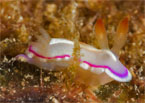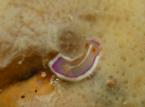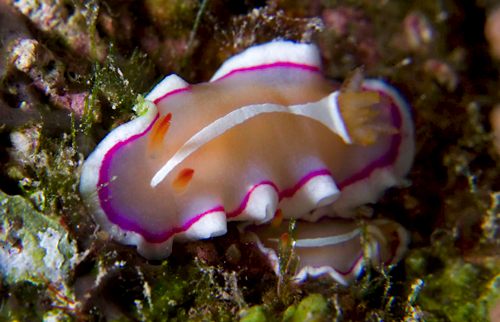| Home |
| Acknowledgments |
| Conventions |
| Glossary |
| Maps |
| References |
| Links |
| Articles |
| Thumbnails |
| Species
list |
| Family |
| Next
species |
Additional Photos

crawling

side

underside

granules?

young

feeding

egg mass
_______________
GALLERY

Verconia sp. #4

| Maximum size: 21 mm. Identification: This species has a cream-white body that is typically pale peach medially (more obviously so as the animal grows in size). An opaque white stripe in the center of the notum is almost always continuous and a magenta line encircles the mantle inside the white mantle margin. The rhinophore lamellae are orange, becoming red-orange near the tips, and the gills are translucent with orange on the outer edges. It can be distinguished from Verconia varians by its unbroken white mid-dorsal stripe and its orange-tipped rhinophores and gills. Natural history: Verconia sp. #4 is a moderately rare species typically found on rocky bottoms, either in the open or on shaded walls, at depths of 3-26 m (10-85 ft). It occurs at moderately exposed to highly exposed sites and feeds on a light gray to cream sponge that is often difficult to see due to other invertebrate growth. (Note 1) On a few occasions, several animals have been observed on a host sponge for over two months, frequently huddled next to each other. (see photo) The spiral egg mass is white and a 13 mm animal laid a 6 mm diameter mass that hatched in about seven days in the laboratory. Distribution: Big Island, Maui, Oahu, Kauai and French Frigate Shoals. Taxonomic notes: This species was listed as Thorunna gloriosa (Bergh, 1874) in Bertsch and Johnson, 1981 (top photo) and was first recorded in Hawaii from Pupukea, Oahu by Scott Johnson on March 22, 1978. It's listed in many sources as a Noumea sp. Photo: John, Mike & Dan Cesere: 17 mm; resting pair: Molokini Islet, Maui; July 24, 2008. Observations and comments: Note 1: Available photos show the species in association with cream and light gray sponges that are similar in texture suggesting that they are color variants of the same species (or closely related). The sponge that the young animal appears to be eating in the first feeding photo is consistent with other sponges photographed in association with Verconia sp. #4. That supports the conclusion that it is actually feeding on that species even though other sponges are in close proximity on the rock. |
| Thumbnails |
Species
list |
Family | Next species | Top |